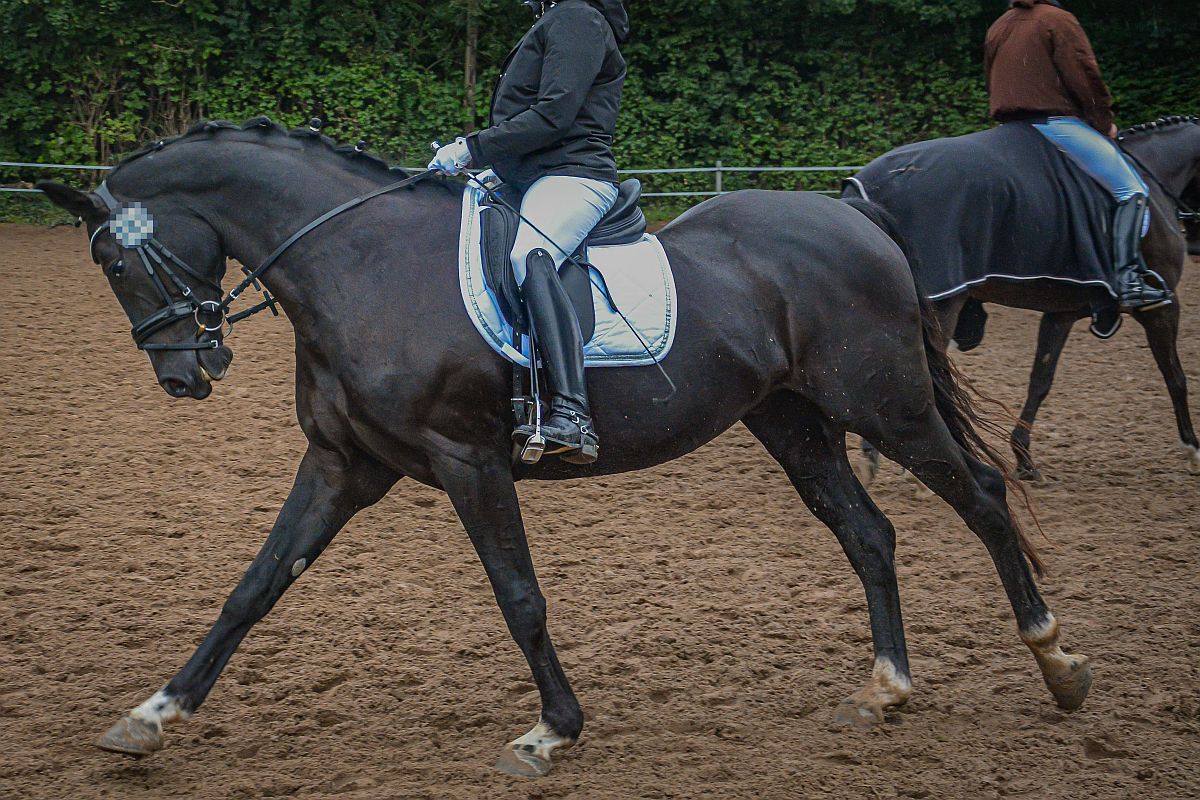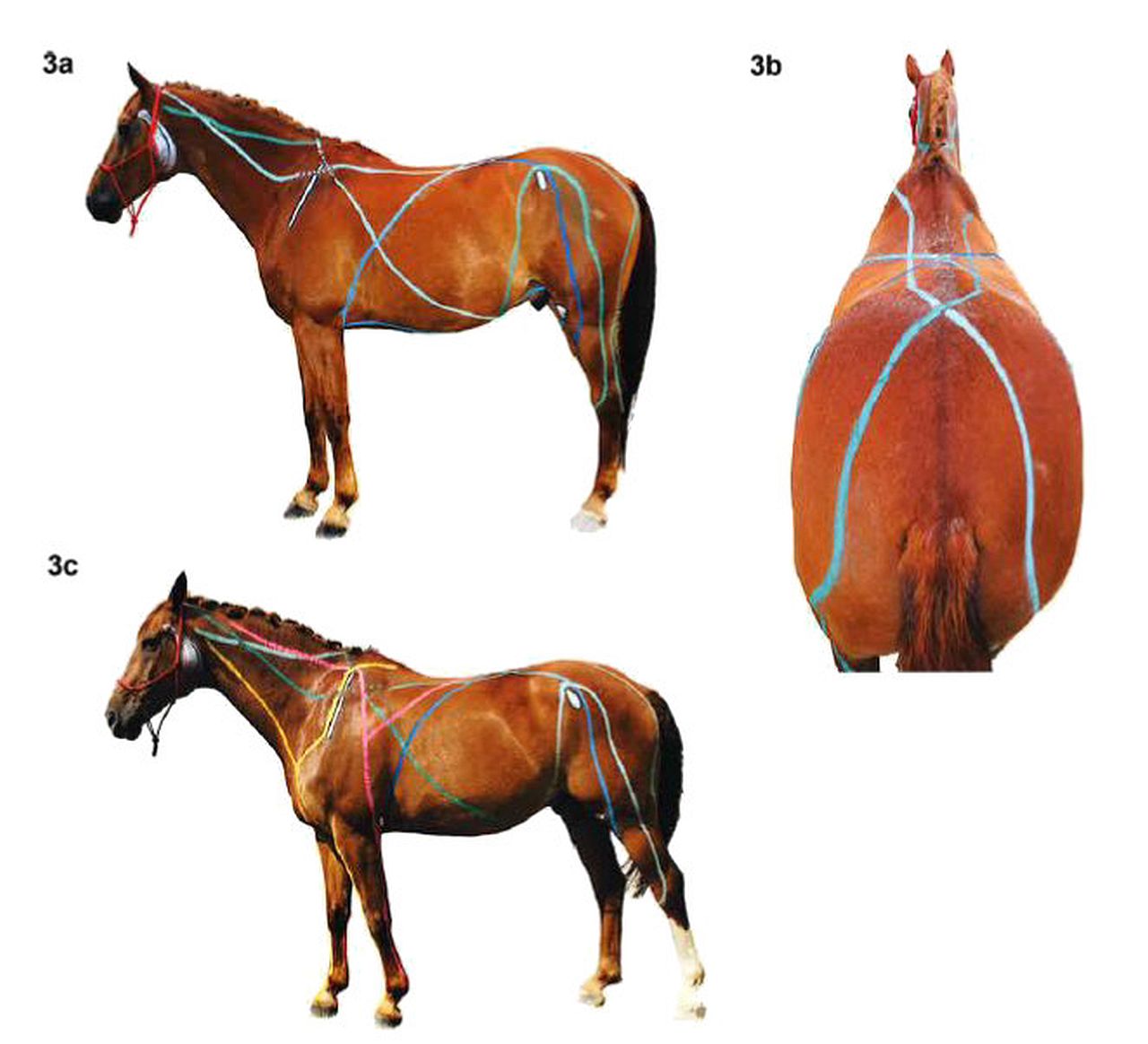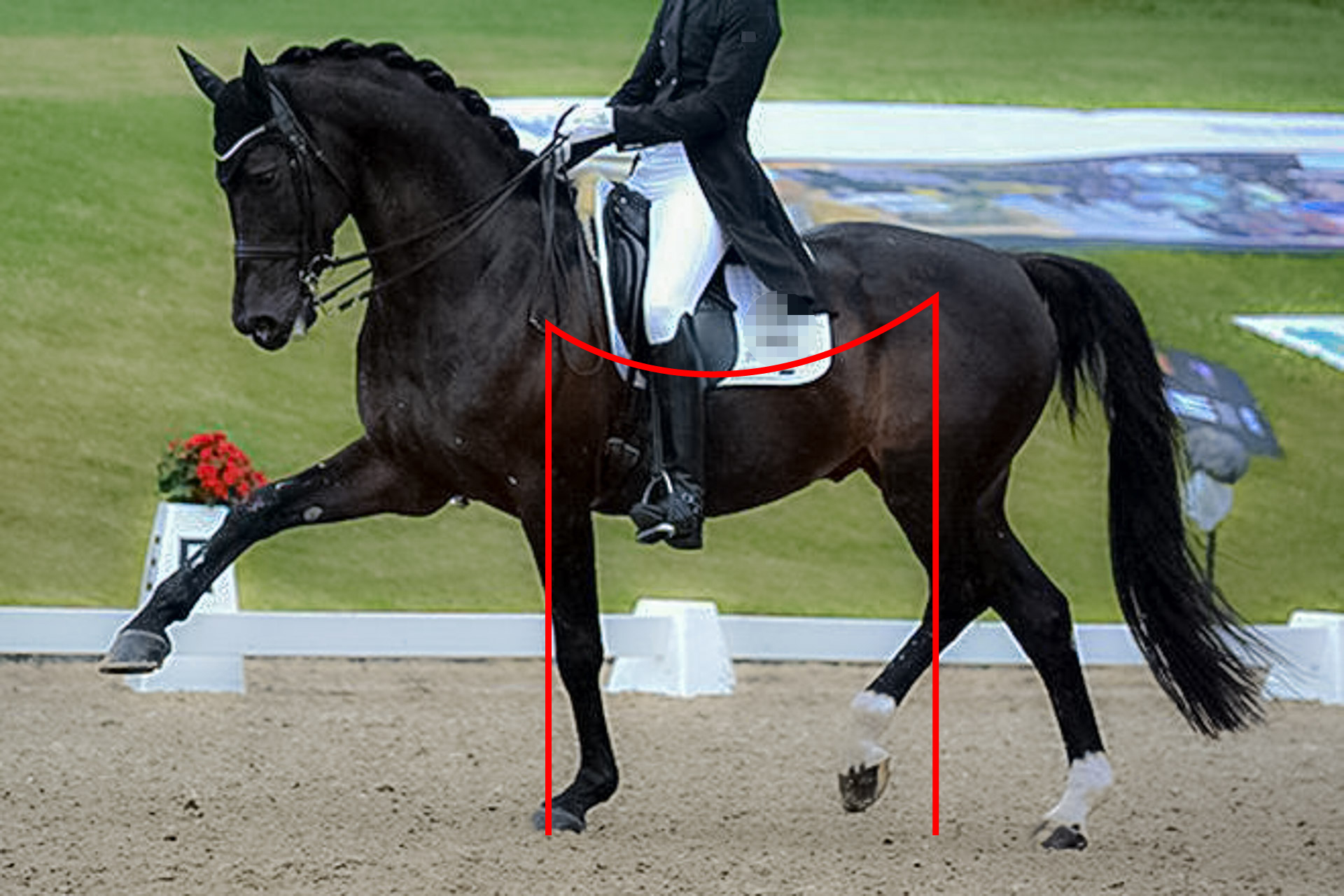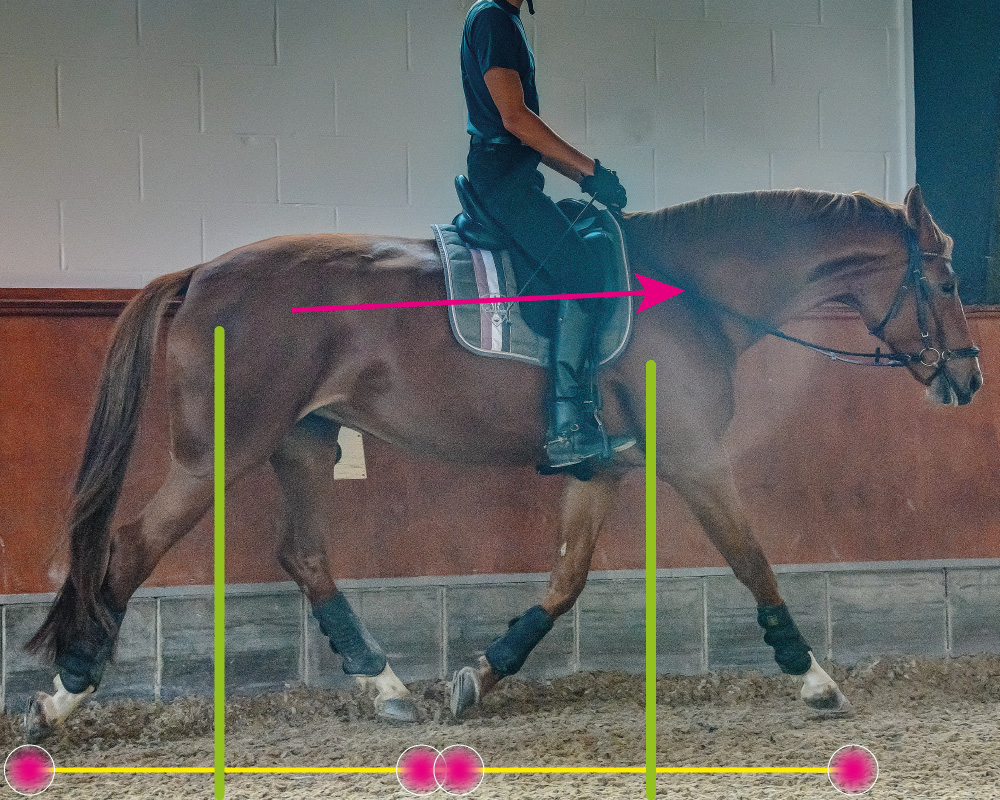Here are a few facts about stetching posture that may be a little guide for you. Because I think that thinking for oneself, then deciding and last but not least but equally important: taking responsibility is the best way to deal with our partner horse.
The stretching posture
Everybody talks about the stretching posture, but who else rides it and what is that anyway?

Everyone can probably see, that this is no stretching posture.
What stretching posture really is, is not so easy to explain. It is often said that the dorsal muscles of the horse, i.e. the upper neck muscles and the back muscles should work in a stretched posture. But it`s not that simple. Actually, the dorsal (backside) muscles and the ventral (abdominal) muscles should work in a kind of balance or in a neutral position. The tone of the dorsal and ventral parts (and of course of the left and right side of the body) is the same. As a result, there is an even tension in all fasciae. So the fascial systems are involved in the carrying work and shock absorption. If the dorsal or ventral or one of the crossed fasciae sag, the horse’s body loses stability and the muscles are put under increased strain.

MYOFASCIA – THE UNEXPLORED TISSUE: MYOFASCIAL KINETIC LINES IN HORSES, A MODEL FOR DESCRIBING LOCOMOTION USING COMPARATIVE DISSECTION STUDIES DERIVED FROM HUMAN LINES Wibeke Sødring Elbrønd, Rikke Mark Schultz, Department of Clinical Veterinary Animal Science, Faculty of Health Sciences, University of Copenhagen; Denmark.
If this happens abnormal movement patterns and osteopathic lesions develop. And the endresult is lameness and injuries to the muscles and ligaments, but also to the joints and bones.
How complex the achievement of a stretching posture actually is, I would like to explain to you using the example of the neck.
Musculature at work in a stretched position
Muscles can never be seen as isolated components, but they always function in a kind of compound system. A muscle A always has an opponent B (antagonist), who has to relax the moment Muskela A tenses up. Otherwise muscle A may contract, but does so against resistance and therefore does not move the joint as it should.
And then muscle A also has synergists, i.e. muscle C, which has a similar but never the same function as muscle A.
This movement is regulated by the nervous system. By gamma- and alpha-neurons and by the proprioceptive system in muscles, tendons and joints.
The major rectus capitis dorsalis muscle and its antagonist the sternocephalic muscle.
The M. rectus capitis dorsalis major is the extensor of the head. When it contracts the horse takes the nose up. This muscle belongs to the dorsal (upper) neck muscles. The sternocephalic muscle is a strong flexor of the head and neck! And it belongs to the ventral (lower) neck muscles. I.e. when this muscle contracts, the horse takes the nose down and rolls down the neck. It is therefore important that this lower neck muscle also works in a stretched position.
Muscular imbalances
On closer inspection, it is easy to see that the flexor is much stronger than the short, narrow head extension.
Therfore the curling of the head and neck – either by the rider’s hand or because the horse offers this position – indicates that the sternocephalicus dominates in its contraction. The smaller head extensor is not able to hold the head in front of the vertical. And the short head extensor is overstretched and detonated.
Activation of the dorsal synergists
Now you can try to ride the horse’s head from behind the vertical to the vertical. Riding to the vertical would then only work via the synergists of the M. rectus capitis dorsalis major. This is because the short head extension cannot maintain an adequate tone and therefore cannot strengthen and train itself.
So the splenius and semispinalis capitis begin to contract. However, there is a problem in the function of these two muscles. If these two muscles have to contribute to the dorsal stabilisation of the head by contraction, not only the upper neck stretching is lost. But because of the S-shape of the neck and the position of the two muscles, the neck gets into an extendet position especially in the area of the 5th to teh 7th cervical vertebra.
This not only increases the pressure on the small vertebral joints from C5 to C7, but on all small vertebral joints of the following vertebrae up to the sacrum.
Activation of the ventral synergists
The brachiocepahilcus muscle also develops hypertension in order to counteract the extension posture. And because it is innervated by the same nerve as the sternomandibulanris muscle, the accessorius nerve (11th cranial nerve). Basically, we now have an extremely short tense neck with an extension in the area of C5 to C7. Additional there is a sagging ventral fascia. This causes an unstable trunk and sagging fetlock joints due to the lack of ventral fascial tension. Also the shoulder joint can no longer stretch completely. The forelimb works exaggeratedly high and no longer works in a uniform manner in front and behind the vertical through the shoulder joint.
This extension posture continues into the caudal area of the spine. That’s why an arching of the back is no longer possible. In addition the thorax falls down between the shoulder blades. therfore the horse does not carry itself and does not straighten up. In this case straightening is done with the reins and it’s called absolute straightening. Recent research shows that this posture could also be the cause of the increased occurrence of head shakers.

Horse ridden from behind the vertical by “activating” hindquarters and “riding forward” to the vertical. Horse in absolute upright position and with the same problems as picture no. 1. The forehand reaches out exaggeratedly. It does not work backwards any more, while the hindquarters are exactly the opposite. And due to the sagging of the back and the detonated abdominal muscles the alleged active hindquarters only work behind the vertical line through the hip joint. That’s why forward momentum is completely missing and the hindquaters are not active. This is not an active hindquarters and the back is not in a stretching position, quite the opposite.
From before the vertical to the vertical
Many of our sport horses today show from the beginning a tendency to curl up and not want to contact the bit. Due to the mechanism of muscle recruitment it is not possible to ride a horse correctly from behind in front of the vertical. And it is also not tolerable to ride horses that are already behind the vertical with bit-contact. The only meaningful correction is to completely reduce the contact and practice the balance. This is done on the one hand by carefully checking the rhythm and on the other hand by treating osteotherapeutic lesions.
Because only a horse whose muscle tone is normalised and even on the left and right, above and below, can find its balance.

Horse walking tactful in front of the vertical, self-supporting and “forward momentum” already developed. The horse actively seeks contact forward against the hand. At this stage it makes sense to give contact. Contact but no standing hand. Leg movement in front of and behind the vertical through the shoulder and hip joints of equal size. Good tone of muscles and fascia, perfect forward momentum and the back in a streching position.
Rhthm makes a dancer
Rhythm has nothing to do with forward. And rhythm can’t be industrious either. Rhythm can only be as fast as the horse is able to finish its movement supple. A restrained pace or expressionless movements are always signs of a lack of balance and thus osteopathic problems and an undeveloped load bearing capacity. Riding beyond the current physiological rhythm does not make the horse’s gait “energetic”. Rather, it always leads to tension in the muscles, to short tense movements and to movement disorders. And musculature is poorly supplied with blood, tends to contractures and shortening of the tonic (support function) and weakening of the phasic muscles (motive muscles).
Correct muscle training in a stretching posture
Here too, less is more. Especially with rhythm. As a point of reference when working on the rhythm: when the horse no longer leans inwards on the circuit, the physiological rhythm is reached. If the horse does not have to lean inwards on the circle line, the load on the joint surfaces is also balanced. So even long lunging does not necessarily harm the joints. It only harms if the joints are loaded differently. And even if the movement looks flat and expressionless at the beginning the rhythm should be slow. If the muscles are damaged or not trained enough, movements often seem flat and expressionless. Musculature learns through repetition. 160 consecutive correct repetitions at a minimum.
And why not forward? Muscles always learn, don’t they? I’ve already given a reason two paragraphs above. The other reason is that fast, far-reaching movements are mainly supported by the energy-storing systems of the horse’s body. Through the fasciae, the energy storing tendons (flexor tendons) and the ligamentous apparatus. So “energic forward” does not train the muscles, but results from the use of these structures. Forward momentum, however, is generated by muscle power and coordinated muscle movement. The expressiveness of the movement develops from coordination, too. However, fasciae and tendons can no longer work when the muscles are tensed and the supply of fluid between muscle and fasciae is reduced.